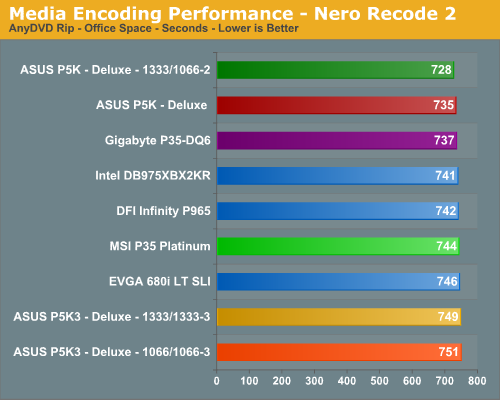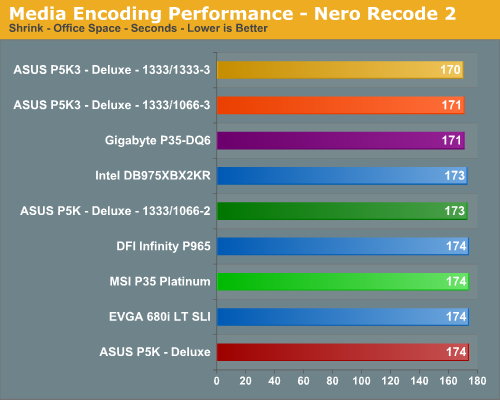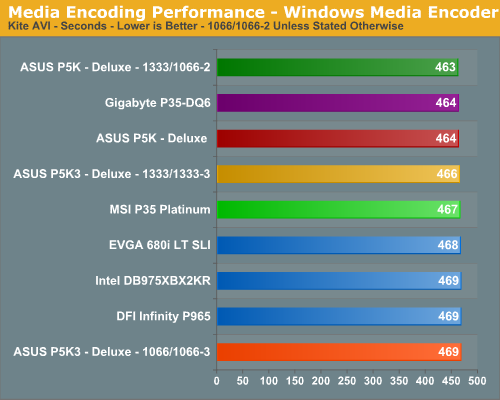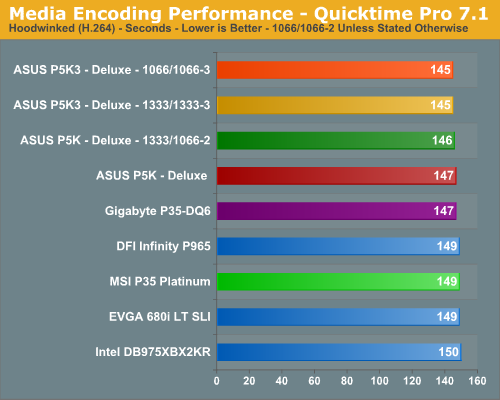Intel P35: Intel's Mainstream Chipset Grows Up
by Gary Key & Wesley Fink on May 21, 2007 3:45 PM EST- Posted in
- CPUs
Media Encoding Performance
We are utilizing an updated video encoding test suite for this article that includes AnyDVD, Nero Recode 2, Windows Media Encoder 9, and QuickTime Pro 7.1.Our first series of tests is quite easy - we take our original Office Space DVD and use AnyDVD and Nero Recode 2 to copy the full DVD to the hard drive without compression, thus providing an almost exact duplicate of the DVD. We then fired up Nero Recode 2, selected our Office Space copy on the hard drive, and performed a shrink operation to allow the entire movie along with extras to fit on a single 4.5GB DVD disc. We then go back and use Nero Recode to shrink the full DVD copy and burn it onto our DVD disc. We left all options on their defaults except we checked off the advanced analysis option. The scores reported include the full encoding process and is represented in minutes/seconds, with lower numbers providing better performance.


The AnyDVD Rip results are very interesting as we did not expect our DDR3 boards to perform in this manner when compared to the DDR2 boards, especially against the same chipset. Even though latencies are higher, the increased bandwidth would normally bring the DDR3 board within range of the DDR2 boards in a test that is CPU and disk intensive. The 3% performance deficit was unusual to say the least. The Shrink results are more in alignment showing a 2% difference between the boards, although for the first time we see the P5K Deluxe board falter a little at stock settings. We noticed at the beginning of the test there was always a brief stutter with this board. The change to 1333FSB really does not improve the scores.
Our next test has us converting our day at the beach AVI file into a high definition WMV file suitable for our Aunt Gertrude to view on her new high definition LCD TV. We ensured our quality settings were set to High Definition. The balance of options is set to standard settings and then we let this program do its magic. We are reporting the numbers in seconds to complete the conversion.

We see the boards with the best overall memory and latency performance once again leading in a test that is both CPU and memory sensitive. The difference is only a rather small 1.3% between the fastest and slowest scores, however.
Next on the list is our QuickTime Pro 7.1 test that will convert our newly downloaded .MOV file into a plasma screen pleasing H264 format. We ensured our quality settings were set to their highest levels and then let the horses loose. The values reported are in minutes/seconds for the conversion time, with lower numbers being better.

Once again, the 1333 platforms have a slight advantage in this test although the differences are minimal. Outside of the MSI board, all of the P35 boards are scoring slightly faster than the older chipsets, and the total range of scores differs by 3.5%.










58 Comments
View All Comments
Comdrpopnfresh - Tuesday, May 22, 2007 - link
The power could be attributed to the DDR3. With it not being so mature there may be a lot of signaling going on that isn't necessary. Also- with all the new technologies, these boards simply have more going on on them. With more transistors on a cpu its is expected they will use more power- more connections and circuits on a board would mean the same. Everything is running faster too. The power consumption doesn't make sense given the lack of matching real-world performance enhancements, but as the article makes good sense in pointing out, Bios are a big contributing factor here.TA152H - Tuesday, May 22, 2007 - link
Except they ran the power tests with DDR2 on P35 based machines as well, and they were higher than P965 with the same memory. So, obviously, that isn't the cause in this instance.Gary Key - Tuesday, May 22, 2007 - link
After speaking with the board manufacturers and Intel, our original thoughts (briefings/white paper review) were confirmed that the additional circuitry required on the P35 DDR3 boards and in the MCH result in the increased power consumption on the DDR3 platform compared to the DDR2 platform. This holds true for the P35 DDR2 boards when compared to the DDR2 P965, the additional DDR3 circuity/instruction set is still active even though it is not being used. This is why you will see the DDR2/DDR3 combo boards shortly. However, the BIOS engineers believe that can work a little magic with the SpeedStep and C1E wait states to reduce power consumption, however we are talking just a few watts at best. More on this subject in the roundup, at least we hope we will have more... ;)TA152H - Tuesday, May 22, 2007 - link
Gary,Thanks, it's useful to know. Are they going to shackle the x38 with DDR2 support too?
Just confirms my earlier opinion, they should have gotten rid of DDR2 support. Intel is an interesting company, they can come out with a great product like the Core 2, and then have some monkey decide to include DDR2 and DDR3 on the P35. You never know if they'll have a clue, or not. I guess it's a good thing they make turkeys like this and the P7, otherwise we wouldn't have AMD. Although AMD might be the cause of this.
The monkey that decided to do this probably thought, "Oh, look what we can do that AMD can't". It seems to me they did that with the P7, a technological marvel way beyond AMD's capability to design, thank goodness, and the groundbreaking Itanium. Except neither one worked great. AMD's pragmatism has paid off nicely, and even though they can't realistically support DDR2 and DDR3 on the same motherboard, I don't think they really care. Of course, I'm just guessing, when a company does something this stupid, it's always difficult to understand why they did it. It would have been so simple to just have DDR3 support for the P35, and let the P965 handle the DDR2 crowd. It's perfectly adequate.
Thanks again for the information. It's disappointing, but with Intel you get used to it. They can't do everything right after all, and still be Intel.
strikeback03 - Wednesday, May 23, 2007 - link
There might be a more practical reason, such as lack of production capability for DDR3 or HP and Dell threatening to use VIA chipsets instead of P35 in order to keep using DDR2 and keep their prices competitive. I doubt consumers would like their prices increasing by a few hundred dollars for no noticeable performance improvement. And if they only keep the computer 3 or 4 years they will probably spend less on energy than on that DDR3.Who knows about X38, I'd guess DDR2 support won't disappear until the chipset revision for Nehalem.
TA152H - Wednesday, May 23, 2007 - link
Well, I agree if P35 were the only choice from Intel, this would be the case, but again, would you buy VIA if you could get a P965? I wouldn't. If the P965 were a lousy, and seriously obsolete chipset, yes, sure, you'd have to come out with something that replaced it. But they could have easily validated it for FSB of 1333, and at the point the only thing really new in the P35 would be the DDR3 support. So, why would you need it?I was going to get the P35 rather than the x38 because I figure x38 will be even more of a power hog considering the, to me, useless features it has. I don't plan on getting two high-end video cards, and I don't think I will run anything that requires twice the performance of the current PCI-E, but if they drop the DDR2 support, it might the one to go after. If you ever look at an Athlon 64 CPU, you can see the memory controller is simply enormous, so dropping it on the x38 could be significant. With it being high end, they may decide DDR2 isn't a high end technology so they drop it. I hope so.
JarredWalton - Monday, May 21, 2007 - link
Could be the Vista factor? I dunno what else to think about the power numbers.XcomCheetah - Wednesday, May 23, 2007 - link
Could you do a little testing on it... why so high power numbers..Secondly if i remember correctly the power number difference between 680i and P965 chipsets was greater than 20W.. but in your current tests the difference is pretty small.? So any guess what has caused this positive change.?
Reference
http://www.anandtech.com/cpuchipsets/showdoc.aspx?...">http://www.anandtech.com/cpuchipsets/showdoc.aspx?...
http://www.xbitlabs.com/articles/chipsets/display/...">http://www.xbitlabs.com/articles/chipsets/display/...
current power numbers on Anandtech
http://www.anandtech.com/cpuchipsets/showdoc.aspx?...">http://www.anandtech.com/cpuchipsets/showdoc.aspx?...